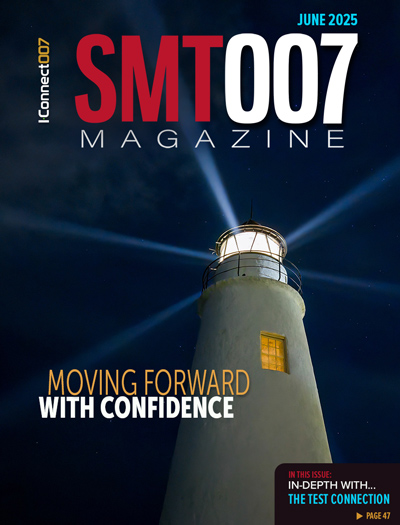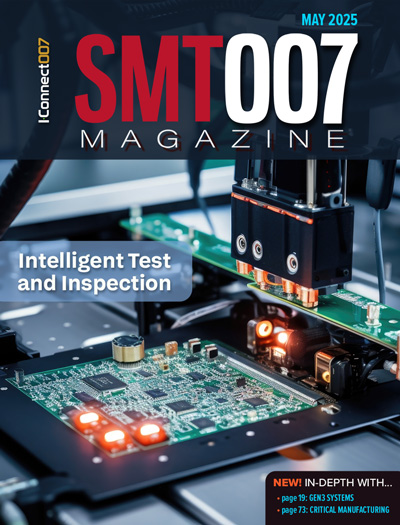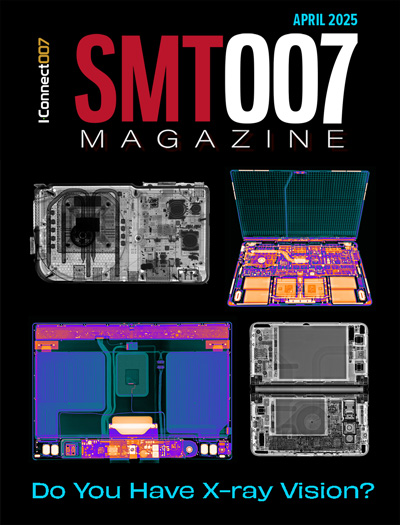-

- News
- Books
Featured Books
- smt007 Magazine
Latest Issues
Current Issue
Moving Forward With Confidence
In this issue, we focus on sales and quoting, workforce training, new IPC leadership in the U.S. and Canada, the effects of tariffs, CFX standards, and much more—all designed to provide perspective as you move through the cloud bank of today's shifting economic market.

Intelligent Test and Inspection
Are you ready to explore the cutting-edge advancements shaping the electronics manufacturing industry? The May 2025 issue of SMT007 Magazine is packed with insights, innovations, and expert perspectives that you won’t want to miss.

Do You Have X-ray Vision?
Has X-ray’s time finally come in electronics manufacturing? Join us in this issue of SMT007 Magazine, where we answer this question and others to bring more efficiency to your bottom line.
- Articles
- Columns
- Links
- Media kit
||| MENU - smt007 Magazine
Digi-Key’s Dave Doherty: Tweaking the Supply Chain
March 8, 2019 | Nolan Johnson and Andy Shaughnessy, I-Connect007Estimated reading time: 5 minutes
Digi-Key COO Dave Doherty discusses supply chain disruptions and shortages and shares a number of ways in which Digi-Key is helping to smooth out the delivery of components even with the current turmoil.
Nolan Johnson: What we want to talk about today is the supply chain.
Andy Shaughnessy: This is a big thing for designers. They’re wondering, “How do you design something for next Christmas when you can’t get the capacitor for 80 weeks?”
David Doherty: That’s the question.
Johnson: Right, which is exactly where we’re going on this, Dave. From Digi-Key’s spot in the supply chain, you have a great view of what’s going on. What do you see as some of the major current drivers right now, plus any challenges?
Doherty: It’s really two-fold. People ask if our businesses are up a considerable amount this year; we’re going to close this year up about 40% after being up 26% last year. So, they say, “What market’s up?” the real answer is, “What market isn’t up?” If you look across industrial, medical, telecommunications, military, aerospace, and automotive, we’re in a very robust part of the cycle where there are more electronics being put into more applications. However, I would say what’s putting the strain on the infrastructure as much as anything is automotive.
We visited a number of Japanese discrete suppliers, and they showed us some charts where in the past, automobiles consumed up to 3,000 MLCCs. There are more than 10,000 now, and you know as well as I do, they’re going into all aspects of automobiles. There are more components in hybrids, and even more in the fully electric cars from the autonomous features, infotainment, and all of the driver assist stuff that we know and love now. The sensors, cameras, monitors, and consumption of electronics are incredible, and even if the automotive market was flat to down (which they aren’t), the consumption rates are up marginally, or they’ve been up. On top of that is increased content per automobile.
So, while that’s not a particularly large end segment, we don’t ship a ton to tier-one automotive. It puts a strain on our suppliers, which has a ripple through effect to the rest of the channel.
Johnson: Right. When your suppliers are selling into their very large customers, even Digi-Key starts to look like a middle tier.
Doherty: No doubt. And you get into questions such as, “What is the cause and effect, and is this different than in the past?” It certainly feels that that way in both the severity and the longevity of it. I would say that what I find is if supply was instantaneous, you’d never have these disruptions. And even though it’s not instantaneous, there’s always the ability, as long as there’s capital available, to add more foundry and capacity. But there’s a little bit more reluctance we’re seeing from suppliers to add capacity. The areas that come to the forefront where there are some of the most commodity of areas, like chip resistors, are the MLCCs that we just mentioned. If you look at those industries and talk to those suppliers, you know the usage is measured in the number of units, so that’s been increasing for the last 20 years or so. But for almost that same time cycle, their overall resales have decreased, so demand for cost reduction in these areas have made it less desirable for the suppliers to continue to invest ahead of the demand and try to keep with it. That’s different than what I’ve seen in the past with memory crunches or other areas of semiconductors.
Johnson: We’re hearing a lot of feedback about product teams running into issues where, surprisingly, even standard commodity parts are being obsoleted way sooner than one would’ve thought.
Doherty: Yes, I would say I back that. From my perspective, I think we’ve seen that as well. I could validate that observation is accurate, and for a lot of these suppliers, it’s coming down to economics. If you have a certain amount of capacity and you’re not going to expand it, where do you make your margins? That’s going to dictate where you’re going to put your wafer starts these days. And some of it is the most standard of commodities that have been impacted the most. The prices have been driven down into the mud, and they’re asked to produce more and more product each year at less and less total resale. It’s a model that’s not sustainable.
Johnson: Some of the feedback we’ve heard, as we’ve been researching this topic, included strategies to start going to the smallest, newest parts that they can use.
Doherty: Clearly, suppliers have been putting their focus on smaller case sizes where they can get more units per wafer and then get a little bit more economies of scale. The other is looking at options, especially if you talk about resistors and capacitors; there are a number of different flavors. I know most of the readers are savvy enough to know you can buy something with a higher tolerance that’s going to be a better-than part.
Put all of those options on your AVL because when you turn those Bills of Materials over to your purchasing folks, more often than not, they’re trying to buy to a part number. More and more today, there are different part numbers. Some are just packaging, some might be a 5000-piece reel versus a 10,000-piece reel. Again, others are better-than or equivalent parts. The more the engineer can specify a broader selection of products on the front end, the better chance the purchasing agent is going to match up to something that’s going to fit that need. That’s just taking the exact need that you have. The more you can work in some flexibility into your design, the better off you’re going to be as well if you can accept a little bit wider range on tolerances in some of these parameters.
To read the full article, which appeared in the January 2019 issue of SMT007 Magazine, click here.
Suggested Items
Intervala Hosts Employee Car and Motorcycle Show, Benefit Nonprofits
08/27/2024 | IntervalaIntervala hosted an employee car and motorcycle show, aptly named the Vala-Cruise and it was a roaring success! Employees had the chance to show off their prized wheels, and it was incredible to see the variety and passion on display.
KIC Honored with IPC Recognition for 25 Years of Membership and Contributions to Electronics Manufacturing Industry
06/24/2024 | KICKIC, a renowned pioneer in thermal process and temperature measurement solutions for electronics manufacturing, is proud to announce that it has been recognized by IPC for 25 years of membership and significant contributions to electronics manufacturing.
Boeing Starliner Spacecraft Completes Successful Crewed Docking with International Space Station
06/07/2024 | BoeingNASA astronauts Barry "Butch" Wilmore and Sunita "Suni" Williams successfully docked Boeing's Starliner spacecraft to the International Space Station (ISS), about 26 hours after launching from Cape Canaveral Space Force Station.
KIC’s Miles Moreau to Present Profiling Basics and Best Practices at SMTA Wisconsin Chapter PCBA Profile Workshop
01/25/2024 | KICKIC, a renowned pioneer in thermal process and temperature measurement solutions for electronics manufacturing, announces that Miles Moreau, General Manager, will be a featured speaker at the SMTA Wisconsin Chapter In-Person PCBA Profile Workshop.
The Drive Toward UHDI and Substrates
09/20/2023 | I-Connect007 Editorial TeamPanasonic’s Darren Hitchcock spoke with the I-Connect007 Editorial Team on the complexities of moving toward ultra HDI manufacturing. As we learn in this conversation, the number of shifting constraints relative to traditional PCB fabrication is quite large and can sometimes conflict with each other.


